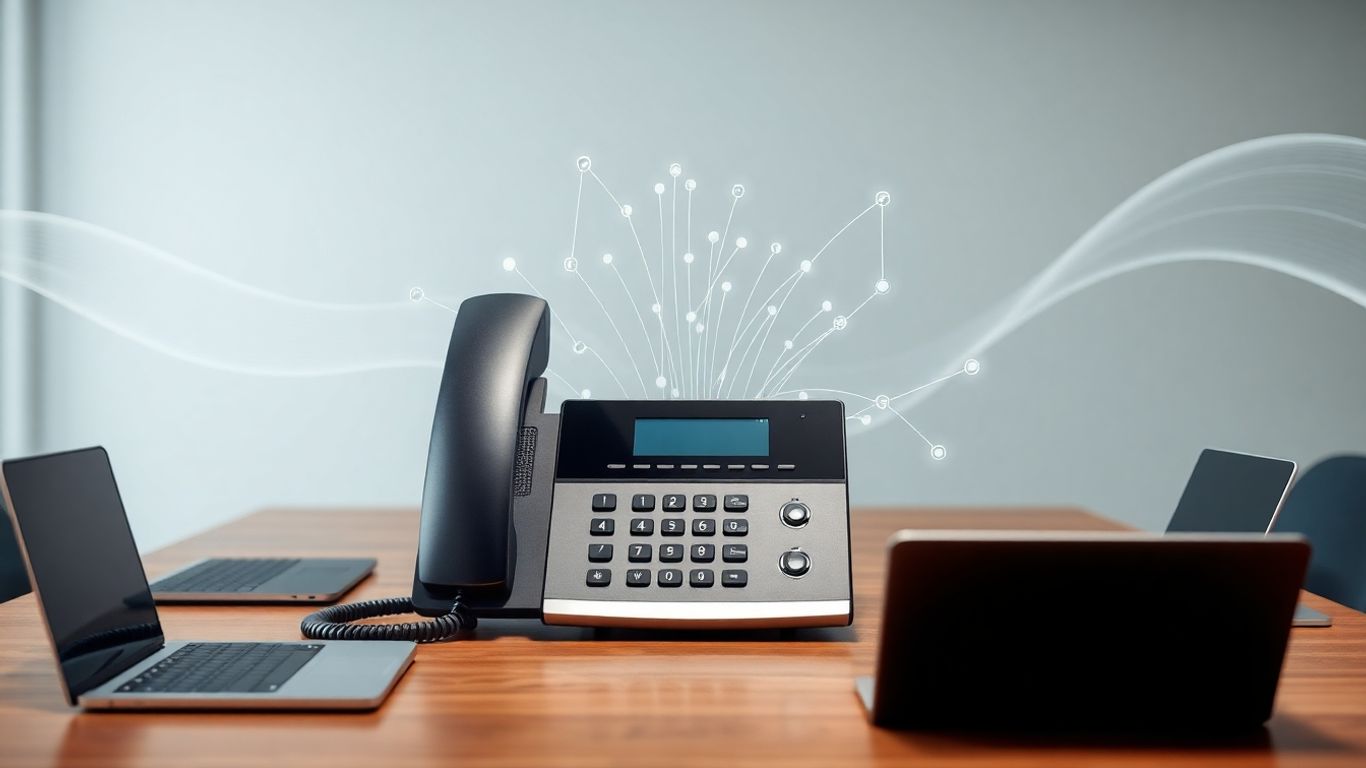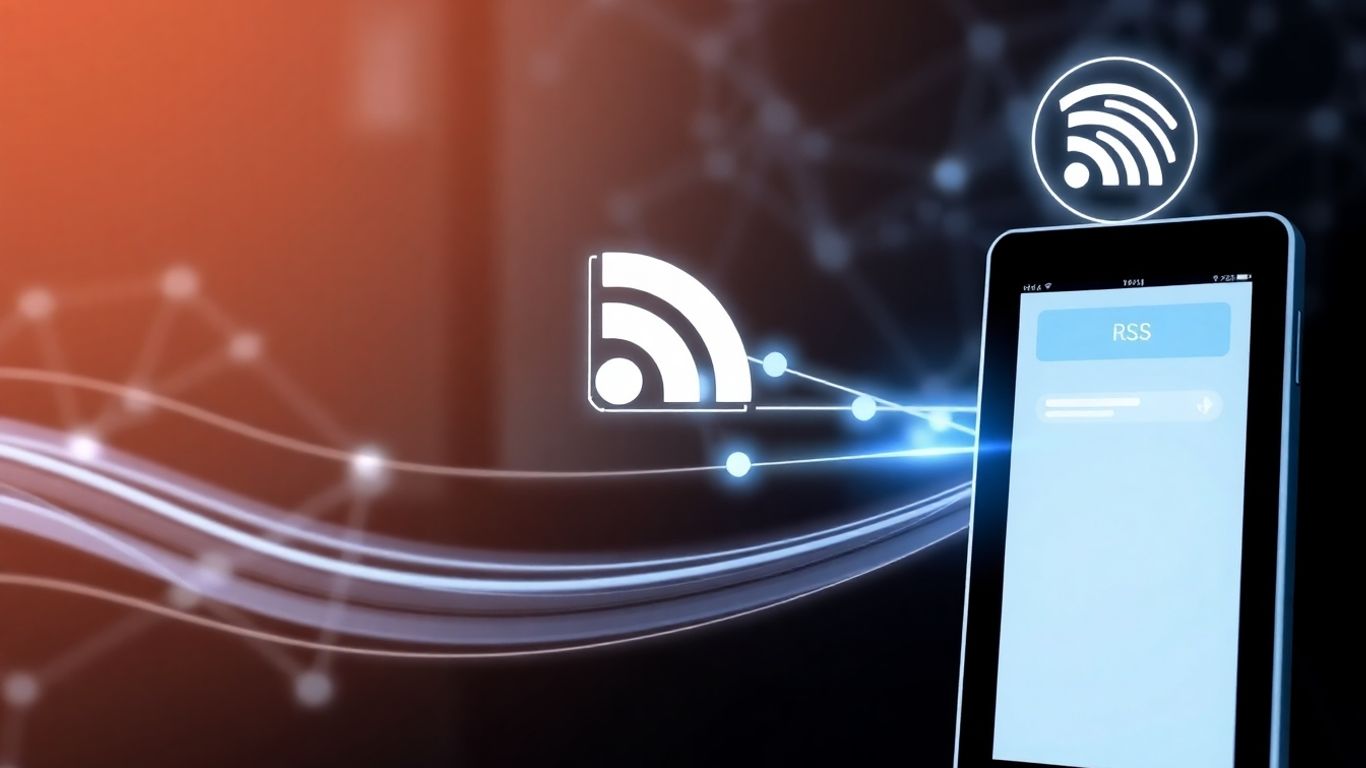These days, keeping your business phone system up-to-date can feel like a constant challenge. You want things to run smoothly, right? Well, there's a way to make your auto attendant do more than just answer calls. By using RSS feeds, you can actually feed it new information automatically. Think of it like giving your phone system a live news ticker. This means callers can get the latest updates without you having to manually change anything. It's a pretty neat trick for making sure everyone stays in the loop.

So, you've got an auto attendant system for your business phone, and you're looking for ways to make it smarter, more dynamic. One really interesting, though maybe a bit old-school, way to do this is by using RSS feeds. Think of RSS (Really Simple Syndication) as a way for websites and services to push out updates in a format that other systems can easily read. For your auto attendant, this means you can pull in information automatically without having to manually update recordings or menus all the time. It's like giving your phone system a direct line to fresh information.
Instead of dialing into your voicemail box to check messages, you can actually use an RSS reader to get them. When a message is marked as read in the reader, it's no longer shown there, but it stays in your mailbox. This is a pretty neat alternative to traditional methods. It's all about making sure the information your callers get is current. You can find more details on setting this up in guides like the System Administration Guide for Cisco Unity Connection.
Imagine your auto attendant greeting changing automatically based on, say, a news feed or a company announcement. That's the power of using RSS feeds. You can set up your system so that when a new item appears in a specific RSS feed, your auto attendant plays that update to callers. This is super useful for things like:
This keeps your callers informed without you needing to be a tech wizard to update recordings. It's a way to make your auto attendant feel alive and responsive to what's happening in your business right now. It's a bit like having a news ticker, but for your phone system. This kind of dynamic content delivery can really make a difference in how callers perceive your business's efficiency.
Using RSS feeds for your auto attendant brings a bunch of good things to the table. The biggest one is definitely having real-time information available to your callers. No more outdated greetings or menus that send people to the wrong place because information changed yesterday. It means callers get the most current details, which builds trust and reduces frustration. Plus, it saves your staff time because they aren't constantly updating recordings. Think about it: instead of recording a new message every time there's a holiday schedule change, the RSS feed can handle it. This is a big win for efficiency. It's a smart way to keep your communication lines open and informative, making sure your business always sounds up-to-date. For businesses looking to automate more tasks, integrating with over 9000 applications through services like Zapier can further streamline these processes, making real-time data flow a reality across your entire operation.
Remember the days of checking a physical voicemail box or sifting through endless audio files? AI is changing that. Now, your AI auto attendant can handle voicemails in a few smart ways. It can transcribe messages, turning spoken words into text you can read. This means you can quickly scan messages without listening to each one. Plus, AI can sort and categorize these messages. Imagine getting a text alert for an urgent message, or having routine inquiries automatically filed away. It's about making sure you don't miss what's important and that the rest is organized without you lifting a finger.
This is where things get really interesting. Your AI auto attendant can actually send text messages during a phone call, based on what's being discussed. Think about it: if a caller asks for pricing, the AI can instantly text them a link to your rate sheet. If they need product specs, it can send over a PDF link. This happens automatically, without interrupting the flow of the conversation. It's like having a super-efficient assistant who knows exactly what information to provide and when. This keeps callers informed and happy, all without needing a human agent to manually send out those details.
Here's a quick look at how these workflows can be set up:
One of the biggest wins with AI auto attendants is sheer speed. We're not talking about just a little faster; we're talking about response times measured in milliseconds. This is fast enough to keep up with natural conversation. When you call a business and get a slow, robotic response, it’s frustrating. AI aims to eliminate that. It doesn't just answer quickly; it processes information quickly. You can ask complex questions, and the AI doesn't hesitate. It feels like talking to someone who knows everything instantly. This speed makes interactions feel smooth and natural, turning a potentially annoying experience into a positive one. It's about making sure your customers feel heard and helped right away, no matter what time they call.
The difference between a slow, clunky interaction and a quick, helpful one can make or break a customer's perception of your business. AI's ability to respond instantly and accurately is a major step forward in customer service.
Your auto attendant system can be set up in a bunch of different ways to handle calls. You can go with the basic setup, which just plays a greeting and then lets callers reach an operator or dial an extension. Or, you can get fancy and build out complex menus. Think about asking callers a series of questions and recording their answers, or offering detailed product information in stages. You could even set it up so calls go to a support team during the day and a voicemail box after hours. It's all about making the system work for you.
It's smart to have a handle on how much your AI receptionist is being used, especially if you're watching your budget. This feature lets you put a cap on the total minutes the AI can be active over a certain time, like a day, week, or month. You can adjust these limits as things change, and the system can even let you know when you're getting close to the maximum. Plus, you can decide what happens when the limit is hit – maybe it goes to voicemail or forwards the call. It's a good way to keep costs predictable and make sure the AI is available when you need it most.
Sometimes, automated systems can stumble over names or technical terms, which can be pretty awkward for the caller. Having a pronunciation guide built into your system helps fix that. You can input specific words or names and tell the system exactly how they should be pronounced. This makes sure that when the auto attendant speaks, it sounds natural and professional, avoiding those embarrassing mispronunciations that can make your business seem less polished. It’s a small detail, but it really makes a difference in how callers perceive your communication.
Connecting your auto attendant to other business tools can really change how things run. It's not just about answering calls anymore; it's about making your whole operation smoother. Think of it like this: your phone system becomes a central hub, talking to all the other apps you use every day.
Zapier is a big player here. It's like a universal translator for your software. You can link your auto attendant to thousands of other applications, making them work together without you having to do anything manually. This means when a call comes in, or a message is left, it can automatically trigger actions in other programs.
For example, you can set up a "Zap" where if someone leaves a voicemail, the system automatically creates a task in your project management tool. Or, if a customer requests information, a follow-up email can be drafted instantly. This kind of automation saves a ton of time and cuts down on simple mistakes.
Seriously, over 9000 apps. That's a lot. This wide reach means that whatever software you're currently using – whether it's a CRM, a marketing platform, a scheduling tool, or even something more niche – there's a good chance it can connect. This makes your auto attendant much more than just a phone feature; it becomes a part of your entire digital ecosystem.
Here are a few ways this connection can help:
The real magic happens with real-time data flow. Information isn't just passed along; it's acted upon instantly. This means your business can react faster to customer needs and internal requests. Imagine a customer calling with an urgent request; the system can immediately flag it, assign it to the right person, and start a timer for response, all without human intervention.
This level of integration transforms a basic auto attendant into a dynamic tool that actively contributes to your business processes. It's about making your communication system work smarter, not just harder, by linking it directly to the tools that drive your daily operations and customer interactions.
This interconnectedness means less time spent on repetitive tasks and more time focusing on what truly matters – growing your business and serving your customers effectively. It's a practical way to boost productivity across the board.
Think of RSS feeds as a way to keep your auto attendant information fresh without you having to manually log in and change things all the time. It's like subscribing to a newspaper for your phone system. When something important happens, like a change in business hours or a special announcement, you can update a single RSS feed, and your auto attendant will automatically pick up that new information. This means callers always get the most current details, which is pretty handy.
Here’s how it can work:
This method is way better than forgetting to update a static recording. It keeps things dynamic and relevant.
RSS feeds really shine when you want your auto attendant to sound like it's actually paying attention to what's going on. Instead of a generic greeting, imagine callers hearing about a flash sale that just started or a new product launch. This kind of dynamic content makes the caller’s experience feel more personal and informative. It shows that your business is active and up-to-date.
The ability to push real-time updates through RSS feeds transforms a standard auto attendant from a static information source into a lively communication channel. It’s about making every call count with timely, relevant information.
This approach helps manage caller expectations and can even guide them towards current offers or important news, making their interaction more productive.
Ultimately, using RSS feeds for your auto attendant is all about making things better for the people calling you. When callers get accurate, up-to-the-minute information, they feel more respected and less frustrated. They don't have to call back later or try to find information elsewhere. It streamlines their interaction with your business.
Consider these points:
It’s a simple step that can make a big difference in how people perceive your customer service.

When you're looking to really make your business phone system work for you, it's not just about answering calls. It's about having tools that make things smoother, faster, and frankly, just better. Think about features that go beyond the basics, the kind that make you wonder how you managed without them.
Remember the old days when you'd call a business and get that dreaded "all circuits are busy" message? It felt like hitting a brick wall. Well, that's pretty much a thing of the past with modern systems. You can handle a huge number of calls all at once. This means no more lost customers because your phone lines are swamped. It's like having an infinite number of receptionists ready to go, no matter how busy things get.
This one's a bit of a hidden gem, but it can really change how you handle information. Imagine being able to share a link to a specific call or a summary of it. It makes tracking conversations, sharing important details with your team, or even just referencing a past interaction so much easier. No more digging through endless call logs or trying to remember who said what. It's about making your call data accessible and useful.
Voicemail has come a long way. Instead of just listening to messages one by one, visual voicemail lets you see a list of your messages, almost like your text messages. You can pick and choose which ones to listen to, delete them easily, or even see transcripts. It saves a ton of time and makes managing messages way less of a chore. You can quickly scan what's important and get back to people faster.
Having these advanced features isn't just about having fancy tech. It's about making your business run more efficiently and giving your customers a better experience. When your phone system works this well, it frees you up to focus on what really matters: running your business.

Think of your auto attendant messages as the first handshake a caller gets. You want it to be firm, clear, and welcoming, right? It’s not just about saying hello; it’s about guiding people efficiently and making them feel like they’ve reached the right place. Getting this right can make a big difference in how people see your business.
When your business closes for the day, your auto attendant message is the last point of contact. It needs to be informative and helpful. Here’s what should be in there:
A well-crafted after-hours message can turn a potentially negative experience into a positive one, showing callers that their business is valued even when you're not available.
Making your messages engaging isn't about fancy words; it's about being clear and friendly. People are often calling because they need something, so a little warmth goes a long way.
Creating good messages used to take time and maybe even a professional voice actor. Now, AI can help speed things up considerably. Tools can help you generate scripts or even record messages in different voices. This means you can get professional-sounding messages out quickly, without a lot of hassle. It’s a way to make sure your communication stays current and professional, even when you’re busy running the actual business. For example, you can quickly create a message about holiday hours or a special event. This kind of dynamic content delivery is a big step up from static greetings. You can even use AI to help with real estate industry communication, ensuring clients get timely updates.

Think about how you get updates for your favorite news sites or blogs. Chances are, you're using an RSS feed. Well, this same technology can actually be a pretty neat way to keep your business phone auto attendant information fresh and current. It's a bit different from the usual way things are done, but it's got some real advantages.
Instead of manually updating every single message on your auto attendant, RSS feeds offer a way to push new information directly into the system. This means if you have a change in hours, a special announcement, or an update on services, you can update one central feed, and your auto attendant can pick it up automatically. It's like having a direct line from your content source to your phone system.
This is where things get really interesting. Some advanced systems let you actually pull your voice messages using an RSS reader. Imagine checking your voicemails right alongside your news updates. When a new message comes in, it shows up in your reader. You can then listen to it, mark it as read, or even forward it. It's a different way to manage your messages, making them accessible from a tool you might already be using.
Keeping your auto attendant messages up-to-date can be a chore. You've got to remember to change the holiday hours, update the special offers, or announce new services. Using RSS feeds can automate a lot of this. You update the feed, and the auto attendant reflects the changes. This is super helpful for:
The beauty of using RSS feeds for your auto attendant is that it centralizes your information. Instead of logging into multiple platforms or making manual changes, you manage your updates in one place. This saves time and significantly reduces the chance of errors or outdated information being presented to your callers.
It's a smart way to make sure your callers always get the most accurate and timely information, making their experience with your business a lot smoother.
Remember the days when missing a call after hours meant a lost customer or a missed opportunity? Those days are pretty much over, thanks to AI receptionists. These systems are designed to be available around the clock, every single day of the year. Think of it like having a dedicated receptionist who never sleeps, never takes a vacation, and never calls in sick. They're always there, ready to pick up the phone. This means no more busy signals for your customers, no matter when they decide to call. It's a big deal for customer satisfaction, especially for businesses that operate in different time zones or have customers who work odd hours. Plus, it really helps when your business experiences a sudden surge in calls – the AI just handles it without breaking a sweat. It's like having an infinite phone line, ready for anything.
AI receptionists aren't just about answering the phone; they're smart. They can actually handle quite a bit of the back-and-forth that usually requires a human. For instance, they can schedule appointments. You tell the AI what your availability looks like, and it can chat with callers, find a suitable time slot, and book it right then and there. No more playing phone tag to find a time that works for everyone. They're also great at answering frequently asked questions. If customers often call to ask about your hours, location, or basic product details, the AI can handle that instantly. It pulls information from a knowledge base you set up, so the answers are always consistent and correct. This frees up your human staff to deal with more complex issues that really need their attention.
Let's talk numbers. Hiring a full-time human receptionist, or even a team of them, can get expensive pretty quickly. You've got salaries, benefits, training, office space, and all the other overhead that comes with employees. An AI receptionist, on the other hand, has a much lower cost of entry and ongoing operational expense. While there's an initial investment or subscription fee, it's typically a fraction of what you'd pay for human staff, especially when you consider they work 24/7. You get consistent service, no matter the hour, without the need for overtime pay or managing shift changes. For many small to medium-sized businesses, this makes a huge difference in their budget, allowing them to provide a higher level of service without breaking the bank. It's a smart way to manage resources and ensure you're not missing out on business simply because you can't afford round-the-clock coverage.
Imagine a receptionist that never sleeps! Our AI receptionists can handle calls around the clock, making sure no customer is ever missed. They're great at answering questions and even booking appointments, freeing up your team to focus on what they do best. Ready to see how this can help your business? Visit our website to learn more and get started!
So, we've talked a lot about how using RSS feeds with your business phone's auto attendant can really change things up. It's not just about answering calls; it's about making sure the right information gets to the right people, right when they need it. Think about how much smoother things can run when your phone system is actually working for you, not against you. It might seem like a small detail, but these kinds of smart updates can make a big difference in how your customers see you, and honestly, how much easier your own day becomes. Give it a try, and see what happens.
Think of an RSS feed like a mini-news update for your phone system. Instead of you constantly checking for new info, the RSS feed automatically sends updates. For a phone auto attendant, this means it can get fresh information, like daily specials or important announcements, without needing someone to manually update it.
RSS feeds let your auto attendant share up-to-date info. Imagine a restaurant's auto attendant using an RSS feed to announce today's soup special or a store's feed sharing a flash sale. It makes the automated greeting more helpful and relevant to callers right now.
They're similar but an AI receptionist is like a super-smart auto attendant. While an auto attendant follows set paths (like 'Press 1 for sales'), an AI receptionist can understand what you're saying, answer more complex questions, and even handle tasks like scheduling appointments, much like a human receptionist would.
Yes! Modern AI is really good at understanding and responding in a natural way. It can keep up with conversations, answer tricky questions, and sound much more human-like than older automated systems. It's designed to make your calls feel smooth and easy.
Zapier is like a connector for different online tools. When your phone system is connected with Zapier, it can automatically do things in other apps. For example, when someone leaves a voicemail, Zapier could automatically create a task in your to-do list app or add their info to your customer list.
Zapier connects to thousands of different apps – over 9,000! This means your phone system can work with almost any other business tool you use, like your email, calendar, customer database, or project management software, making everything work together smoothly.
Visual Voicemail is like having your voicemails appear as a list on your phone screen, similar to text messages. You can see who called, listen to messages in any order, and manage them easily without having to call into a voicemail box. It makes checking messages much quicker and simpler.
AI can help write and even record messages for your auto attendant. You can tell it what information you need to convey, like your business hours or special offers, and the AI can generate clear, professional-sounding messages for you. It saves time and makes sure your messages sound great.
Start your free trial for My AI Front Desk today, it takes minutes to setup!








